
Inverness is a city in the Scottish Highlands, having been granted city status in 2000. It is the administrative centre for The Highland Council and is regarded as the capital of the Highlands.
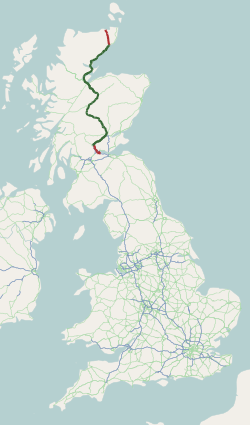
The A9 is a major road in Scotland running from the Falkirk council area in central Scotland to Scrabster Harbour, Thurso in the far north, via Stirling, Bridge of Allan, Perth and Inverness. At 273 mi (439 km), it is the longest road in Scotland and the fifth-longest A-road in the United Kingdom. Historically it was the main road between Edinburgh and John o' Groats, and has been called the spine of Scotland. It is one of the three major north–south trunk routes linking the Central Belt to the Highlands – the others being the A82 and the A90.
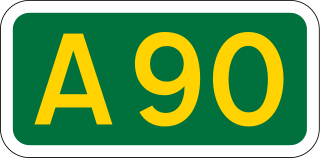
The A90 road is a major north-to-south road in eastern Scotland, running from Edinburgh to Fraserburgh, through Dundee and Aberdeen. Along with the A9 and the A82 it is one of the three major north–south trunk roads connecting the Central Belt to northern destinations.

The A66 is a major road in Northern England, which in part follows the course of the Roman road from Scotch Corner to Penrith. It runs from east of Middlesbrough in North Yorkshire to Workington in Cumbria. The road has been progressively improved with dual carriageway sections, but with stretches of single carriageway road. The road is set to be completely dualled between Scotch Corner and Penrith, with a £1.3 billion scheme being announced in March 2024.
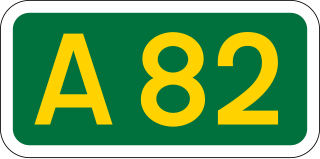
The A82 is a major road in Scotland that runs from Glasgow to Inverness via Fort William. It is one of the principal north-south routes in Scotland and is mostly a trunk road managed by Transport Scotland, who view it as an important link from the Central Belt to the Scottish Highlands and beyond. The road passes close to numerous landmarks, including Loch Lomond, Rannoch Moor, Glen Coe, the Ballachulish Bridge, Ben Nevis, the Commando Memorial, Loch Ness, and Urquhart Castle. Along with the A9 and the A90 it is one of the three major north–south trunk roads connecting the Central Belt to the North.

The M90 is a motorway in Scotland. It runs from Junction 1A of the M9 motorway, south of the Queensferry Crossing, to Perth. It is the northernmost motorway in the United Kingdom. The northern point goes to the western suburbs of Perth at Broxden. A small part of the M90 was originally numbered as the M85 motorway.
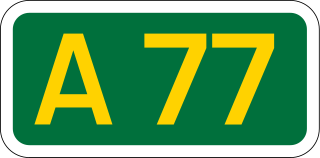
The A77 road is a major road in Scotland. It runs in a southwesterly direction from the city of Glasgow, past the towns of Giffnock, Newton Mearns, Kilmarnock, Prestwick, Ayr, Girvan and Stranraer to the village of Portpatrick on the Irish Sea. It passes through the council areas of Glasgow City, East Renfrewshire, East Ayrshire, South Ayrshire and Dumfries and Galloway.

The A75 is a primary trunk road in Scotland, linking Stranraer and its ferry ports at Cairnryan with the A74(M) at Gretna, close to the border with England and the M6 motorway.

The A92 is a major road that runs through Fife, Dundee, Angus, Aberdeenshire, and Aberdeen City in Scotland. From south to north, it runs from Dunfermline to Blackdog, just north of Aberdeen.

The A96 is a major road in the north of Scotland.

The Midland Highway is one of Tasmania's major inter-city highways, running for 176 kilometres (109 mi) between Hobart and Launceston. It is part of the AusLink National Network and is a vital link for road freight to transport goods to and from the two cities. It represents a major north–south transportation corridor in Tasmania and has the route 1 designation as part of the National Highway. The highway consists of various traffic lane arrangements, the most common being two lanes – one in each direction, with overtaking options and at-grade intersections. At both the Launceston and Hobart sections of the highway there are small portions of grade-separated dual carriageway.

The N4 road is a national primary road in Ireland, running from Dublin to the northwest of Ireland and Sligo town. The M6 to Galway diverges from this route after Kinnegad, while the N5 to Westport diverges at Longford town. Most sections of the N4 that are motorway-standard are designated the M4 motorway.
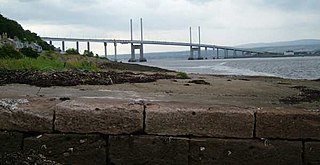
The Kessock Bridge carries the A9 trunk road across the Beauly Firth at Inverness, Scotland.

Broxden Junction is one of the busier and more important road junctions in Scotland. It is located on the outskirts of Perth, and is one of the city's two major roundabouts – the other being Inveralmond Roundabout, where the A9 meets the A912 Dunkeld Road, 2.3 miles (3.7 km) to the north-northwest. The roundabout, oval in shape, is an important hub of the Scottish road network, a major junction on the A9 north–south route, and the UK's northernmost motorway junction, being junction 12 of the M90 motorway. Prior to Dunfermline's ascension to city status, all of the seven cities in Scotland were signposted from its exits.
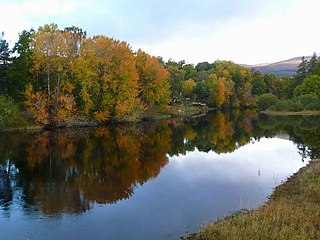
Kincraig is a village located north of Kingussie and south of Aviemore in Highland, Scotland. Its original name was Boat of Inch, reflecting the ferry boat crossing of the Spey River that once operated here but the name was changed after a single track bridge was erected in 1871.

Plans are in place to construct a southern bypass that would link the A9, A82 and A96 together involving crossings of the Caledonian Canal and the River Ness in the Torvean area, southwest of the city. The bypass, known as the Inverness Trunk Road Link (TRL), is aimed at resolving Inverness’s transport problems and has been split into two separate projects, the east and west sections. Also proposed is the upgrade of the existing B8082 Southern Distributor Road to dual 2-lane carriageway or single 4-lane carriageway, that will connect the two sections together.

Road speed limits in the United Kingdom are used to define the maximum legal speed for vehicles using public roads in the UK.

In 2011, Transport Scotland envisioned a plan to upgrade the remaining 90 miles of the A9, a trunk road in Scotland, between Perth and Inverness from a single carriageway to a dual carriageway. According to this plan, the road will be widened from one to two lanes per direction, and will also have a central reservation. It also means there will be an increase in speed for cars and motorcycles from 60 mph to 70 mph.

The Jubilee Bridge is a 254 m (833 ft) road bridge over the River Tay near Dunkeld in Scotland. The bridge conveys the A9 road over the river. A concrete box bridge also joins the Jubilee Bridge at its southern end as it carries the A9 over the Highland Main Line. The area of the River Tay below the bridge is accessible for personal watercraft and walkers. As part of the A9 dualling project, the bridge will be duplicated by 2032.



















